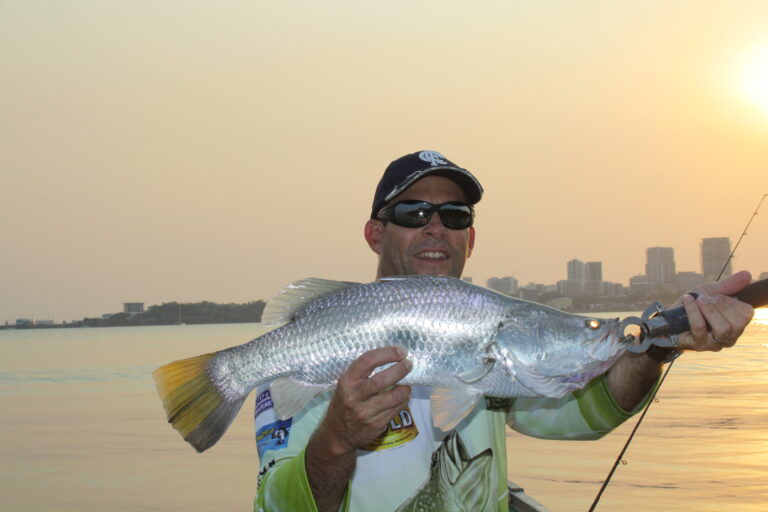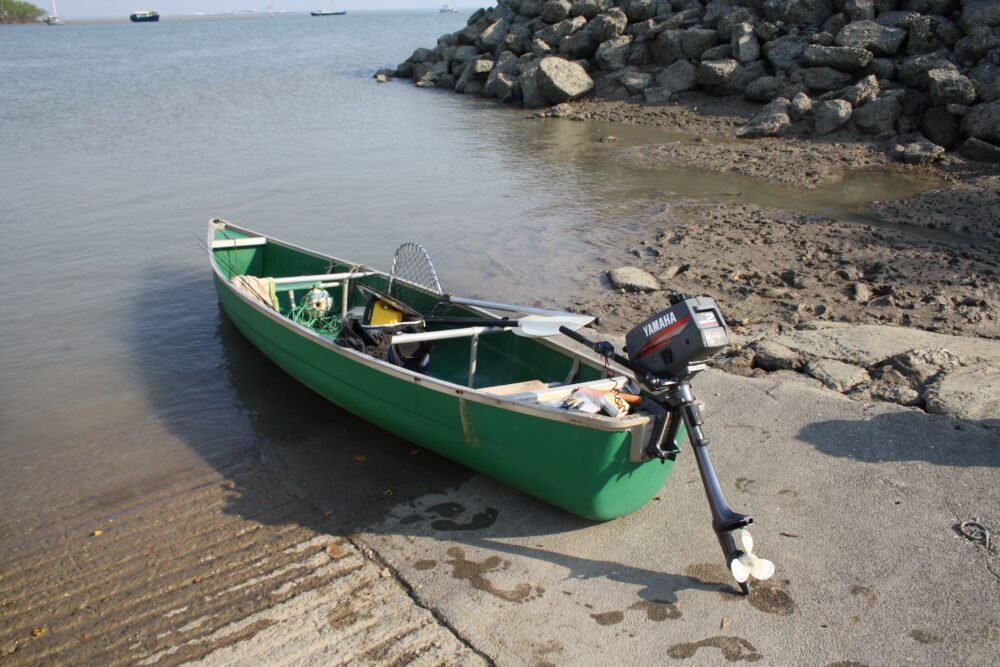Canoe fishing in Darwin Harbour – By Chris Errity
A good mate of mine Wayne Baldwin has been fishing Darwin Harbour for some time now in his 14-foot canoe. He mainly fishes on his own due to the ease of using a canoe and being able to fish the flats in a vessel that can easily move through a foot of water quietly. He has a 4hp motor fitted so he can reach the areas he wants to fish quickly and then once he arrives he uses the quiet stealth approach with his paddle. Some may think he is tempting fate with the local crocodile population present where he fishes, but he has had no issues with these reptilian hunters at any stage while fishing the harbour. Still he will be the first to admit that he is always wary of their presence and will move on if one shows a little too much interest in him.
For some time now I have been interested in fishing with Wayne to observe his techniques and see just how easy it is for two anglers to fish out of a canoe. He has been incredibly successful over the years using this approach and has landed many barra accordingly. So when the opportunity arose to have a fish with him one afternoon after work I jumped at the chance. This particular afternoon Wayne decided to fish the flats opposite Dinah beach boat ramp on an incoming spring tide. He prefers fishing spring tides that rise to about 7m in height as many barra move along these flats on the incoming tide to feed. Wayne had fished the same area the afternoon before, landing four barra and dropping many which is why he had invited me to come with him the next day to have another crack at them, even though the tidal movement was significantly less.
I met Wayne down at the Dinah beach ramp just before 5pm. The tide had turned and just reached the bottom of the ramp. Wayne secures his canoe on a purpose built box trailer. It only takes him around three minutes to remove the canoe from the trailer and drop it on the side of the ramp. The small outboard is then placed on the transom of the canoe and we are ready to roll. The canoe has a surprising amount of room and could easily accommodate the two of us plus a couple of tackle boxes and rods. The tide was still a little low to fish the flats and so we cast around the rocks near Tipperary Waters where Wayne has landed several good barra before. At around 5.30pm we moved across to the flats to fish a small gutter on the incoming tide.
The water was extremely low but we managed to position ourselves within casting distance of the gutter. We used a small anchor to hold ourselves in the prime position.
The water had only just reached the gutter on the edge of the mangroves and already the barra were starting to feed in only six inches of water. They were almost lying on their sides as they chased the mullet across the flats.
The water clarity was not good, but Wayne assured me it would clean up a little as the tide rose. He also let me know that we only had a little under an hour before the water would rise too high and the good fishing would cease as the barra would move into the mangroves.
There were many aerial roots present on the edge of the flat and Wayne said the best fishing occurred just as the tide rose over them. He was not wrong as he soon had his first fish to the canoe. At around 50cm in length, this was a common sized barra for the harbour. Wayne was using one of his small homemade timber minnows in a silver mullet colour, which is all he uses when fishing the harbour. It is a shallow diving twitch minnow which works extremely well when fishing shallow waters on the flats around snake drains and small gutters. I used a small Reidys B52 as the water was so shallow.
It was not long before Wayne landed another fish and this one was just legal at 55cm. The tide was pushing in quickly and the water clarity did indeed begin to improve.The barra seemed to be laying up beside the aerial roots as they moved across the flats towards the gutter. I received my first strike from a feisty fish which still managed to peel me into the mangroves. It is amazing how much power these small fish have in short bursts. The hooks pulled and the fish escaped. Wayne had another two strikes before he planted the hooks in the next fish and landed another barra in the 50’s. Soon after I hooked and landed my first barra for the session at 62cm. The water level had risen considerably now and was around 50cm deep. The mullet were now less prevalent as they had moved up into the mangroves.
The barra continued to strike our lures on the edge of the aerial roots, but it was difficult to hook-up properly. Many of them were soft, frustrating strikes, and so difficult to stick the hooks in. However, we still managed to land a few more barra between us before the tide had risen too much just on sunset. With a total of six barra landed between us and many more lost it had been an extremely enjoyable hour session fishing out of a canoe only five minutes away from one of Darwin’s most busy ramps. I was most impressed with the stability of the canoe and how useful it was for this type of fishing. The two of us could quite easily stand up in the canoe and cast our lures with precision without losing our balance. We returned to the ramp just before 7pm and packed the canoe up before heading home after another successful barra trip so close to home.









